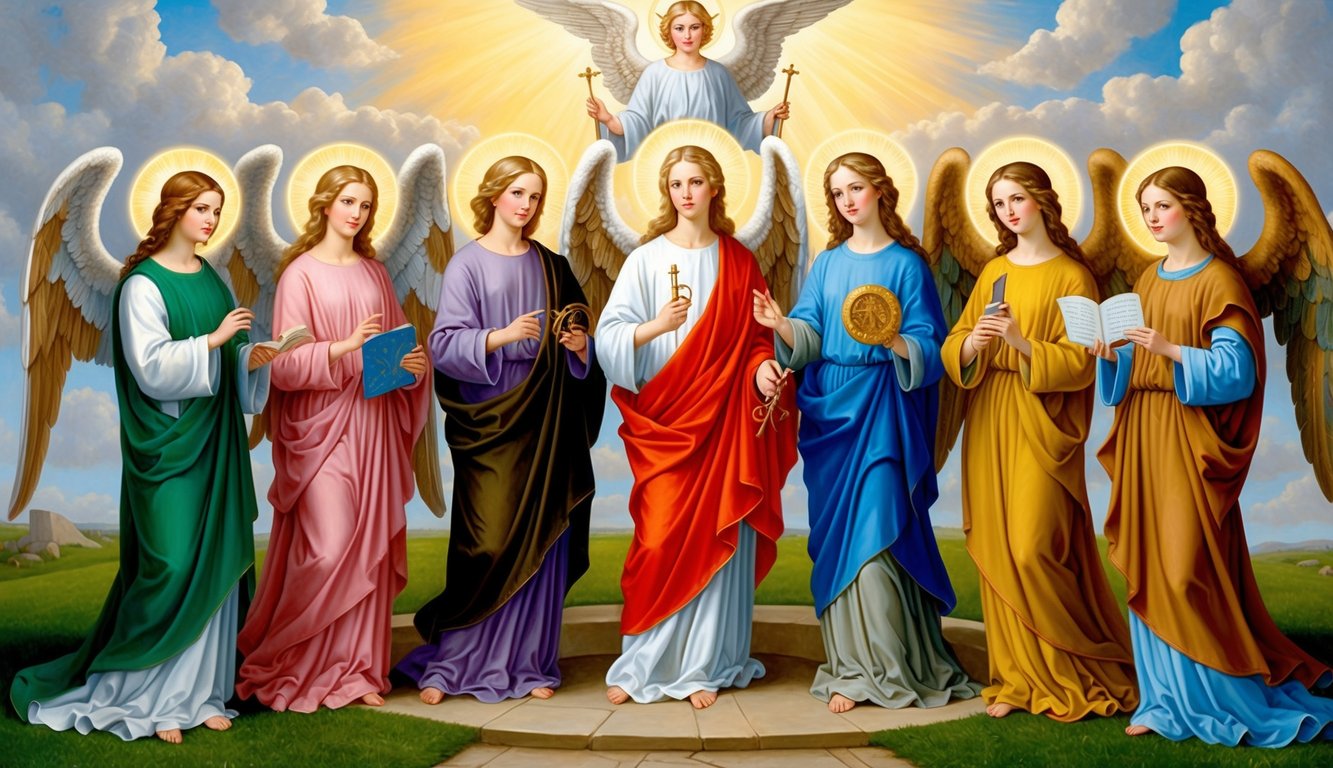Don’t Miss Out On This Unique Astrological Opportunity
Are you tired of spinning your wheels and getting nowhere? Simply put, you’re out of sync: you’re out of alignment with your astral configuration.
But: there’s a kind of map that can help you reclaim your alignment. Think of it as your own personal blueprint to success and happiness: a blueprint that will help you live your most amazing life.
Get started here.
Angels are often pictured as gentle beings with wings and halos, but their descriptions in the Bible tell a more varied story. Biblically accurate angels aren’t always what you might imagine; they can appear with multiple wings, wheels, and even eyes covering their bodies.
These vivid depictions invite you to explore how these heavenly beings are portrayed across different texts and understand their roles and significance.
In biblical narratives, angels are more than just messengers.
They are warriors, guides, and sometimes terrifying visions.
By examining the descriptions found in the scriptures, you get a deeper understanding of how angels interact with humanity and what their true forms entail.
Diving into this topic opens up a world of fascinating stories and interpretations.
Discover how angels like Michael and Gabriel fit into these stories and what their appearances mean within the broader context of biblical literature.
The diverse roles and representations of angels across the Bible challenge the simple, serene images that are more commonly seen today.
This exploration not only enriches your knowledge but also deepens your appreciation for these spiritual beings.
Understanding Angelic Beings in Scriptures
In the Bible, angels take on many roles and have different forms and ranks.
From their appearances in visions to their roles as messengers, these celestial beings play a significant part in unfolding divine plans.
Angels in the Bible
In the Bible, angels are often seen as messengers of God.
They appear in Genesis, guiding humanity and delivering important messages.
For instance, an angel stopped Abraham from sacrificing his son, Isaac.
In Exodus, they provide protection and guidance as the Israelites travel through the wilderness.
In the New Testament, they announce births, including to Mary about Jesus.
Angels also appear at key events, such as Jesus’ resurrection, where they speak to the women at the tomb.
Different types of angels include seraphim and cherubim, which are often depicted with multiple wings and serve roles of worship and protection.
Heaven’s Hierarchy
Angels are arranged in a heavenly hierarchy with different ranks.
At the top are archangels like Michael, who plays a key role in battles against evil.
Seraphim are closest to God and known for their fiery presence, often described in Isaiah as having six wings.
Cherubim have a protective role and appear as guardians around sacred spaces.
They are depicted in the visions of Ezekiel, with faces resembling different creatures.
This hierarchy reflects the different tasks and functions angels fulfill, from delivering messages to guarding divine realms.
Depictions of Angelic Forms
Angels in the Bible have unique forms and roles that can seem strange or magnificent.
Understanding these forms offers insights into their significance and purpose in biblical teachings.
Biblical Descriptions of Angels
In the Bible, angels often appear as powerful and mysterious beings.
They are sometimes described as having a radiant appearance, with their faces shining like lightning.
Angels often have wings, although the number can vary.
Scriptures describe some angels as having six wings.
Fire is another common element in these descriptions, adding to their awe-inspiring presence and highlighting their divine nature.
These detailed depictions emphasize an angel’s role as a messenger and servant of God.
Seraphim and Cherubim
Seraphim and Cherubim are specific types of angels that differ in their forms and duties.
Seraphim are often portrayed around the throne of God and have six wings and eyes.
Two wings cover their faces, two cover their feet, and two are for flying.
Cherubim, on the other hand, are often described as having four wings and a number of faces, including those of a lion, an ox, an eagle, and a man.
These beings are associated with protecting holy places or objects, showing their importance in maintaining divine order and presence.
The Four Living Creatures
The Four Living Creatures are unique entities seen in visions, especially in the books of Ezekiel and Revelation.
Each of these creatures has four faces: a man, a lion, an ox, and an eagle, representing different aspects of God’s creation.
They are described as having multiple wings and are full of eyes, even on the wheels they move with, referred to as ophanim.
These creatures constantly praise God with a loud voice, emphasizing their role in worship and their closeness to divine power.
Angelic Roles and Responsibilities

Biblically, angels have crucial roles like delivering messages from God and shielding people from harm.
They are often depicted carrying out these duties with dedication and care.
Messengers of God
Angels serve as messengers of God, conveying His will and guidance to humans.
This role is significant in biblical stories.
For example, the angel Gabriel announced the births of both John the Baptist and Jesus.
When angels deliver messages, they bring important revelations, warnings, or instructions.
As messengers, they sometimes appear in dreams or visions, ensuring God’s words reach those who need them.
Their presence in these moments highlights their role in communicating divine plans and assuring believers that God is actively involved in the world.
Guardians and Protectors
Angels are also depicted as guardians and protectors. Guardian angels are believed to watch over individuals, offering protection and comfort.
The Bible often describes angels shielding people during times of danger.
For instance, they protected Daniel in the lions’ den and guided the Israelites in the wilderness.
These angels provide divine safety, ensuring that God’s faithful followers are safeguarded from harm.
Although unseen, their protective actions remind believers of God’s constant presence and the comfort they offer in challenging situations.
This assurance strengthens faith and trust in God’s care.
Notable Angels and Their Stories

In biblical texts, angels appear in various roles, from divine messengers to spiritual warriors.
The stories of Archangels Michael and Gabriel, along with Satan’s fall, feature prominently in Christian teachings.
These narratives highlight themes of good versus evil, divine power, and significant events from biblical history.
Archangel Michael
Michael is often described as a powerful warrior angel.
He plays a critical role in the Book of Revelation, where he leads the angelic army against Satan.
He is known as an archangel, a title given to angels of high rank.
Michael’s strength and leadership are associated with the fight for good against evil forces.
In the Book of Jude, Michael disputes with the devil over the body of Moses.
This story illustrates his loyalty and dedication.
Michael’s protective nature is also evident, and he is seen as a guardian of the faithful and a defender against evil.
Archangel Gabriel
Gabriel is best known for his role as a messenger.
In the Gospel of Luke, he brings an important message to Mary, announcing the upcoming birth of Jesus.
This story, known as the Annunciation, marks a key moment in Christian teachings.
Gabriel’s appearances emphasize his role in conveying divine messages.
In the Book of Daniel, he explains visions to the prophet, showcasing his role in interpreting and revealing divine plans.
Gabriel’s voice and presence are seen as a bridge between God and humanity, providing guidance and clarity.
Satan: The Fallen Angel
Satan’s story is one of the most well-known accounts of a fallen angel.
Initially a high-ranking angel, his ambition led to a rebellion against God, resulting in his fall from grace.
This narrative is prominent in texts like Genesis and the Book of Revelation.
The fall of Satan signifies the struggle between good and evil.
He is often referred to as the devil, representing the forces opposed to God.
Despite his fall, his influence persists throughout the Bible, tempting and challenging the faithful.
This ongoing battle underscores the importance of faith and resistance against evil.
Spiritual Significance of Angels Today

Angels play a crucial role in connecting the spiritual realm with humanity.
They influence modern religious thought and practices.
Angels and Humanity
Angels have a significant role in the relationship between spiritual beings and humanity.
According to biblical texts, angels are often seen as messengers from God, bringing guidance and support to human beings.
In the Garden of Eden, angels were present to guide Adam and Eve, representing divine love and protection.
You may find comfort knowing that angels are considered protectors, watching over people and helping them find faithful paths in life.
Their invisible presence can provide a sense of security and peace.
Many believe these spiritual beings serve as guardians during times of uncertainty.
Angels in Modern Theology
In today’s religious context, angels hold a meaningful place in theology.
They are often seen as symbols of purity and divine power.
In modern Christian theology, angels are visible expressions of God’s love.
They act as guides to help you on your spiritual journey.
These beliefs emphasize the role of angels in aiding salvation, providing insights into God’s will.
They are seen as part of God’s creation, bridging the gap between the divine and human existence.
You might find that their presence in religious teachings reinforces faith and offers hope in challenging times.



